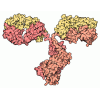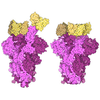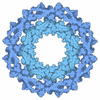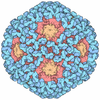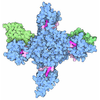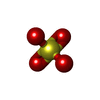[English] 日本語
 Yorodumi
Yorodumi- PDB-9px5: Crystal structure of Fab 7268 in complex with MBP-TREM2 Ig domain... -
+ Open data
Open data
- Basic information
Basic information
| Entry | Database: PDB / ID: 9px5 | ||||||
|---|---|---|---|---|---|---|---|
| Title | Crystal structure of Fab 7268 in complex with MBP-TREM2 Ig domain fusion | ||||||
 Components Components |
| ||||||
 Keywords Keywords | IMMUNE SYSTEM / Fab / antibody / complex | ||||||
| Function / homology |  Function and homology information Function and homology informationpositive regulation of high-density lipoprotein particle clearance / regulation of toll-like receptor 6 signaling pathway / positive regulation of complement activation, classical pathway / detection of lipoteichoic acid / regulation of macrophage inflammatory protein 1 alpha production / regulation of hippocampal neuron apoptotic process / regulation of plasma membrane bounded cell projection organization / positive regulation of C-C chemokine receptor CCR7 signaling pathway / excitatory synapse pruning / positive regulation of CD40 signaling pathway ...positive regulation of high-density lipoprotein particle clearance / regulation of toll-like receptor 6 signaling pathway / positive regulation of complement activation, classical pathway / detection of lipoteichoic acid / regulation of macrophage inflammatory protein 1 alpha production / regulation of hippocampal neuron apoptotic process / regulation of plasma membrane bounded cell projection organization / positive regulation of C-C chemokine receptor CCR7 signaling pathway / excitatory synapse pruning / positive regulation of CD40 signaling pathway / negative regulation of triglyceride storage / negative regulation of cell activation / detection of peptidoglycan / positive regulation of macrophage fusion / import into cell / sulfatide binding / negative regulation of macrophage colony-stimulating factor signaling pathway / positive regulation of antigen processing and presentation of peptide antigen via MHC class II / negative regulation of fat cell proliferation / lipoteichoic acid binding / positive regulation of engulfment of apoptotic cell / positive regulation of establishment of protein localization / positive regulation of synapse pruning / microglial cell activation involved in immune response / negative regulation of toll-like receptor 2 signaling pathway / negative regulation of autophagic cell death / respiratory burst after phagocytosis / negative regulation of astrocyte activation / positive regulation of CAMKK-AMPK signaling cascade / semaphorin receptor binding / positive regulation of low-density lipoprotein particle clearance / positive regulation of microglial cell migration / detection of lipopolysaccharide / apolipoprotein A-I binding / Other semaphorin interactions / T cell activation via T cell receptor contact with antigen bound to MHC molecule on antigen presenting cell / CXCL12-activated CXCR4 signaling pathway / negative regulation of toll-like receptor 4 signaling pathway / negative regulation of neuroinflammatory response / high-density lipoprotein particle binding / negative regulation of p38MAPK cascade / very-low-density lipoprotein particle binding / cellular response to oxidised low-density lipoprotein particle stimulus / negative regulation of glial cell apoptotic process / complement-mediated synapse pruning / dendritic cell differentiation / microglial cell proliferation / semaphorin receptor complex / positive regulation of microglial cell activation / phagocytosis, recognition / amyloid-beta clearance by cellular catabolic process / low-density lipoprotein particle binding / negative regulation of NLRP3 inflammasome complex assembly / cellular response to lipoprotein particle stimulus / regulation of resting membrane potential / positive regulation of phagocytosis, engulfment / regulation of TOR signaling / cellular response to peptidoglycan / peptidoglycan binding / regulation of oxidative stress-induced neuron intrinsic apoptotic signaling pathway / positive regulation of chemotaxis / positive regulation of amyloid-beta clearance / positive regulation of potassium ion transport / semaphorin receptor activity / phosphatidylethanolamine binding / positive regulation of proteasomal protein catabolic process / positive regulation of osteoclast differentiation / negative regulation of amyloid fibril formation / cellular response to lipid / kinase activator activity / regulation of interleukin-6 production / dendritic spine maintenance / apoptotic cell clearance / negative regulation of interleukin-1 beta production / phagocytosis, engulfment / regulation of innate immune response / phosphatidylserine binding / pyroptotic inflammatory response / regulation of cytokine production involved in inflammatory response / detection of maltose stimulus / negative regulation of cholesterol storage / maltose transport complex / cellular response to lipoteichoic acid / lipid homeostasis / amyloid-beta clearance / lipoprotein particle binding / carbohydrate transport / positive regulation of ATP biosynthetic process / positive regulation of intracellular signal transduction / humoral immune response / regulation of lipid metabolic process / positive regulation of interleukin-10 production / apolipoprotein binding / plasma membrane raft / negative regulation of tumor necrosis factor production / social behavior / carbohydrate transmembrane transporter activity / maltose binding / positive regulation of cholesterol efflux / positive regulation of TOR signaling Similarity search - Function | ||||||
| Biological species |   Homo sapiens (human) Homo sapiens (human) | ||||||
| Method |  X-RAY DIFFRACTION / X-RAY DIFFRACTION /  SYNCHROTRON / SYNCHROTRON /  MOLECULAR REPLACEMENT / Resolution: 3.7 Å MOLECULAR REPLACEMENT / Resolution: 3.7 Å | ||||||
 Authors Authors | Arndt, J.W. / Chao, Q. / Cooke, H.A. / Almeida, A.D.S. | ||||||
| Funding support | 1items
| ||||||
 Citation Citation |  Journal: Mabs / Year: 2025 Journal: Mabs / Year: 2025Title: Building a potent TREM2 agonistic, biparatopic, common light chain antibody. Authors: da Silva Almeida, A. / Geddie, M.L. / Bhate, A. / Quan, C. / Arndt, J.W. / Jiao, Y. / Santoro, J.C. / Noiman, L. / Vijayakumar, R. / Sanchez-Salazar, J. / Datta, A. / Antognetti, G. / ...Authors: da Silva Almeida, A. / Geddie, M.L. / Bhate, A. / Quan, C. / Arndt, J.W. / Jiao, Y. / Santoro, J.C. / Noiman, L. / Vijayakumar, R. / Sanchez-Salazar, J. / Datta, A. / Antognetti, G. / Hartana, C.A. / Wang, X.F. / Smith, B.A. / Bartlett, D. / Duncan, D. / Liu, C.C. / Otero Gutierrez, K. / Cameron, T.O. / Koirala, S. / Cooke, H.A. | ||||||
| History |
|
- Structure visualization
Structure visualization
| Structure viewer | Molecule:  Molmil Molmil Jmol/JSmol Jmol/JSmol |
|---|
- Downloads & links
Downloads & links
- Download
Download
| PDBx/mmCIF format |  9px5.cif.gz 9px5.cif.gz | 185.4 KB | Display |  PDBx/mmCIF format PDBx/mmCIF format |
|---|---|---|---|---|
| PDB format |  pdb9px5.ent.gz pdb9px5.ent.gz | 139.8 KB | Display |  PDB format PDB format |
| PDBx/mmJSON format |  9px5.json.gz 9px5.json.gz | Tree view |  PDBx/mmJSON format PDBx/mmJSON format | |
| Others |  Other downloads Other downloads |
-Validation report
| Summary document |  9px5_validation.pdf.gz 9px5_validation.pdf.gz | 740.3 KB | Display |  wwPDB validaton report wwPDB validaton report |
|---|---|---|---|---|
| Full document |  9px5_full_validation.pdf.gz 9px5_full_validation.pdf.gz | 745.5 KB | Display | |
| Data in XML |  9px5_validation.xml.gz 9px5_validation.xml.gz | 35 KB | Display | |
| Data in CIF |  9px5_validation.cif.gz 9px5_validation.cif.gz | 45.4 KB | Display | |
| Arichive directory |  https://data.pdbj.org/pub/pdb/validation_reports/px/9px5 https://data.pdbj.org/pub/pdb/validation_reports/px/9px5 ftp://data.pdbj.org/pub/pdb/validation_reports/px/9px5 ftp://data.pdbj.org/pub/pdb/validation_reports/px/9px5 | HTTPS FTP |
-Related structure data
| Related structure data |  9pwnC C: citing same article ( |
|---|---|
| Similar structure data | Similarity search - Function & homology  F&H Search F&H Search |
- Links
Links
- Assembly
Assembly
| Deposited unit | 
| ||||||||
|---|---|---|---|---|---|---|---|---|---|
| 1 |
| ||||||||
| Unit cell |
|
- Components
Components
| #1: Protein | Mass: 54172.066 Da / Num. of mol.: 1 / Fragment: Ig domain of TREM-2 Source method: isolated from a genetically manipulated source Source: (gene. exp.)   Homo sapiens (human) Homo sapiens (human)Gene: malE, b4034, JW3994, TREM2 / Cell line (production host): HEK293 / Production host:  Homo sapiens (human) / References: UniProt: P0AEX9, UniProt: Q9NZC2 Homo sapiens (human) / References: UniProt: P0AEX9, UniProt: Q9NZC2 | ||||
|---|---|---|---|---|---|
| #2: Antibody | Mass: 24081.043 Da / Num. of mol.: 1 Source method: isolated from a genetically manipulated source Source: (gene. exp.)  Homo sapiens (human) / Production host: Homo sapiens (human) / Production host:  | ||||
| #3: Antibody | Mass: 23363.852 Da / Num. of mol.: 1 Source method: isolated from a genetically manipulated source Source: (gene. exp.)  Homo sapiens (human) / Production host: Homo sapiens (human) / Production host:  | ||||
| #4: Polysaccharide | alpha-D-glucopyranose-(1-4)-beta-D-glucopyranose | ||||
| #5: Chemical | | Has ligand of interest | N | Has protein modification | Y | |
-Experimental details
-Experiment
| Experiment | Method:  X-RAY DIFFRACTION / Number of used crystals: 1 X-RAY DIFFRACTION / Number of used crystals: 1 |
|---|
- Sample preparation
Sample preparation
| Crystal | Density Matthews: 3.04 Å3/Da / Density % sol: 59.51 % |
|---|---|
| Crystal grow | Temperature: 293 K / Method: vapor diffusion, sitting drop / pH: 6 / Details: 11% PEG 8000, 240mM ammonium sulfate, 100mM MES |
-Data collection
| Diffraction | Mean temperature: 100 K / Serial crystal experiment: N |
|---|---|
| Diffraction source | Source:  SYNCHROTRON / Site: SYNCHROTRON / Site:  SLS SLS  / Beamline: X06SA / Wavelength: 1.000039 Å / Beamline: X06SA / Wavelength: 1.000039 Å |
| Detector | Type: DECTRIS EIGER X 16M / Detector: PIXEL / Date: Apr 9, 2022 |
| Radiation | Protocol: SINGLE WAVELENGTH / Monochromatic (M) / Laue (L): M / Scattering type: x-ray |
| Radiation wavelength | Wavelength: 1.000039 Å / Relative weight: 1 |
| Reflection | Resolution: 3.7→50 Å / Num. obs: 13219 / % possible obs: 99.21 % / Redundancy: 7.1 % / CC1/2: 0.85 / Net I/σ(I): 5.3 |
| Reflection shell | Resolution: 3.7→4 Å / Num. unique obs: 2514 / CC1/2: 0.73 |
- Processing
Processing
| Software |
| ||||||||||||||||||||||||||||||||||||||||||
|---|---|---|---|---|---|---|---|---|---|---|---|---|---|---|---|---|---|---|---|---|---|---|---|---|---|---|---|---|---|---|---|---|---|---|---|---|---|---|---|---|---|---|---|
| Refinement | Method to determine structure:  MOLECULAR REPLACEMENT / Resolution: 3.7→47.05 Å / SU ML: 0.57 / Cross valid method: FREE R-VALUE / σ(F): 1.35 / Phase error: 30.42 / Stereochemistry target values: ML MOLECULAR REPLACEMENT / Resolution: 3.7→47.05 Å / SU ML: 0.57 / Cross valid method: FREE R-VALUE / σ(F): 1.35 / Phase error: 30.42 / Stereochemistry target values: ML
| ||||||||||||||||||||||||||||||||||||||||||
| Solvent computation | Shrinkage radii: 0.9 Å / VDW probe radii: 1.1 Å / Solvent model: FLAT BULK SOLVENT MODEL | ||||||||||||||||||||||||||||||||||||||||||
| Refinement step | Cycle: LAST / Resolution: 3.7→47.05 Å
| ||||||||||||||||||||||||||||||||||||||||||
| Refine LS restraints |
| ||||||||||||||||||||||||||||||||||||||||||
| LS refinement shell |
|
 Movie
Movie Controller
Controller


 PDBj
PDBj